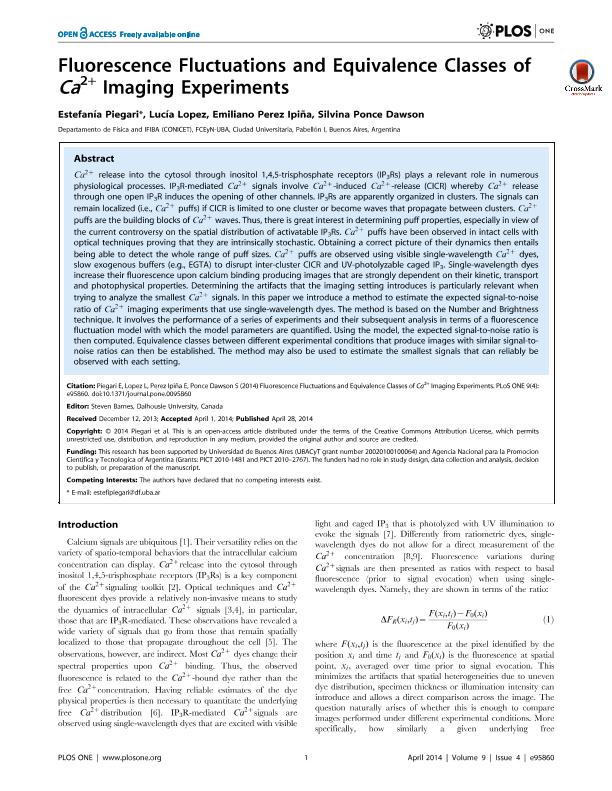Artículo
Fluorescence Fluctuations and Equivalence Classes of Ca2+ Imaging Experiments
Fecha de publicación:
04/2014
Editorial:
Public Library Of Science
Revista:
Plos One
ISSN:
1932-6203
Idioma:
Inglés
Tipo de recurso:
Artículo publicado
Clasificación temática:
Resumen
Ca2z release into the cytosol through inositol 1,4,5-trisphosphate receptors (IP3Rs) plays a relevant role in numerous physiological processes. IP3R-mediated Ca2z signals involve Ca2z-induced Ca2z-release (CICR) whereby Ca2z release through one open IP3R induces the opening of other channels. IP3Rs are apparently organized in clusters. The signals can remain localized (i.e., Ca2z puffs) if CICR is limited to one cluster or become waves that propagate between clusters. Ca2z puffs are the building blocks of Ca2z waves. Thus, there is great interest in determining puff properties, especially in view of the current controversy on the spatial distribution of activatable IP3Rs. Ca2z puffs have been observed in intact cells with optical techniques proving that they are intrinsically stochastic. Obtaining a correct picture of their dynamics then entails being able to detect the whole range of puff sizes. Ca2z puffs are observed using visible single-wavelength Ca2z dyes, slow exogenous buffers (e.g., EGTA) to disrupt inter-cluster CICR and UV-photolyzable caged IP3. Single-wavelength dyes increase their fluorescence upon calcium binding producing images that are strongly dependent on their kinetic, transport and photophysical properties. Determining the artifacts that the imaging setting introduces is particularly relevant when trying to analyze the smallest Ca2z signals. In this paper we introduce a method to estimate the expected signal-to-noise ratio of Ca2z imaging experiments that use single-wavelength dyes. The method is based on the Number and Brightness technique. It involves the performance of a series of experiments and their subsequent analysis in terms of a fluorescence fluctuation model with which the model parameters are quantified. Using the model, the expected signal-to-noise ratio is then computed. Equivalence classes between different experimental conditions that produce images with similar signal-tonoise ratios can then be established. The method may also be used to estimate the smallest signals that can reliably be observed with each setting.
Archivos asociados
Licencia
Identificadores
Colecciones
Articulos(IFIBA)
Articulos de INST.DE FISICA DE BUENOS AIRES
Articulos de INST.DE FISICA DE BUENOS AIRES
Citación
Piegari, Estefanía; Lopez, Lucía Fernanda; Perez Ipiña, Emiliano; Ponce Dawson, Silvina Martha; Fluorescence Fluctuations and Equivalence Classes of Ca2+ Imaging Experiments; Public Library Of Science; Plos One; 9; 4; 4-2014; 1-18; e95860
Compartir
Altmétricas




